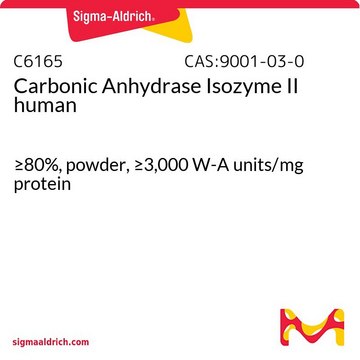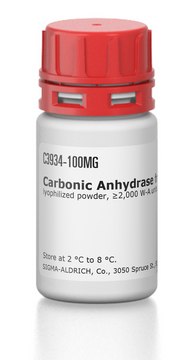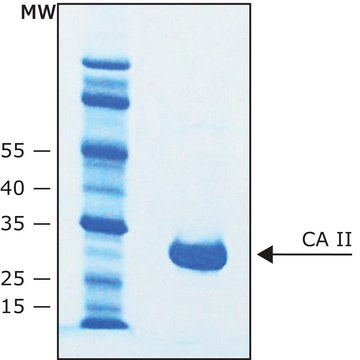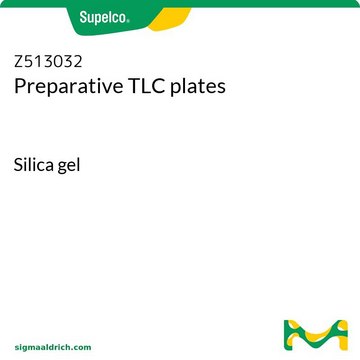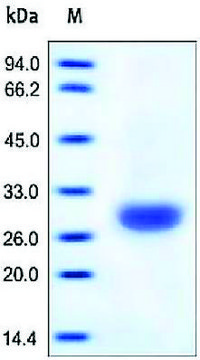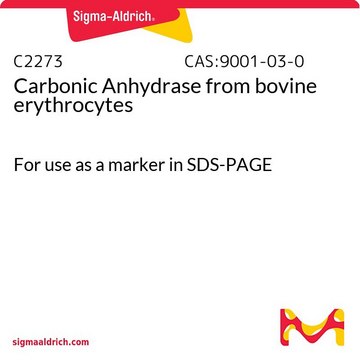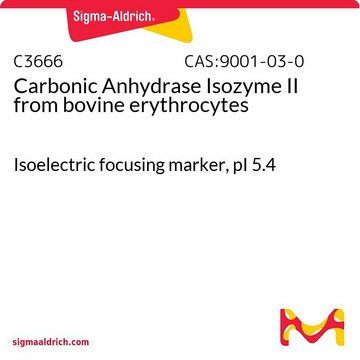C4396
Carbonic Anhydrase I from human erythrocytes
Synonyme(s) :
Carbonate Dehydratase, Carbonate Hydrolyase, Carbonic Anhydrase Isozyme I
Se connecterpour consulter vos tarifs contractuels et ceux de votre entreprise/organisme
About This Item
Produits recommandés
Forme
powder
Activité spécifique
100-500 W-A units/mg protein
Poids mol.
30 kDa
Couleur
white
pl
~6.6
Numéro d'accès UniProt
Température de stockage
−20°C
Informations sur le gène
human ... CA1(759)
Vous recherchez des produits similaires ? Visite Guide de comparaison des produits
Application
Carbonic anhydrase from human erythrocytes (HCA) has been used to study the molten-globule state of carbonic anhydrase (CA). Chaperone-like α-crystallin binds to this state of the enzyme and prevents its aggregation. The enzyme from sigma has been used for the analysis of thermodynamic stability of the enzyme. Furthermore, its clinical significance has been evaluated in human non-small cell lung cancer.
Actions biochimiques/physiologiques
Carbonic anhydrase is a zinc metalloenzyme that has a molecular weight of approximately 30,000 Da. The enzyme catalyzes the hydration of carbon dioxide to carbonic acid. It is involved in vital processes such as pH and CO2 homeostasis, transport of bicarbonate and CO2, biosynthetic reactions, bone resorption, calcification, and tumorigenicity. Therefore, this enzyme is an important target for inhibitors with clinical applications in various pathologies such as glaucoma, epilepsy and Parkinson′s disease.
Définition de l'unité
One Wilbur-Anderson (W-A) unit will cause the pH of a 0.02 M Trizma buffer to drop from 8.3 to 6.3 per min at 0 °C. (One W-A unit is essentially equivalent to one Roughton-Booth unit.)
Notes préparatoires
chromatographically
purified.
purified.
Inhibiteur
Réf. du produit
Description
Tarif
Mention d'avertissement
Danger
Mentions de danger
Conseils de prudence
Classification des risques
Resp. Sens. 1
Code de la classe de stockage
11 - Combustible Solids
Classe de danger pour l'eau (WGK)
WGK 3
Point d'éclair (°F)
Not applicable
Point d'éclair (°C)
Not applicable
Faites votre choix parmi les versions les plus récentes :
Déjà en possession de ce produit ?
Retrouvez la documentation relative aux produits que vous avez récemment achetés dans la Bibliothèque de documents.
Les clients ont également consulté
Notre équipe de scientifiques dispose d'une expérience dans tous les secteurs de la recherche, notamment en sciences de la vie, science des matériaux, synthèse chimique, chromatographie, analyse et dans de nombreux autres domaines..
Contacter notre Service technique